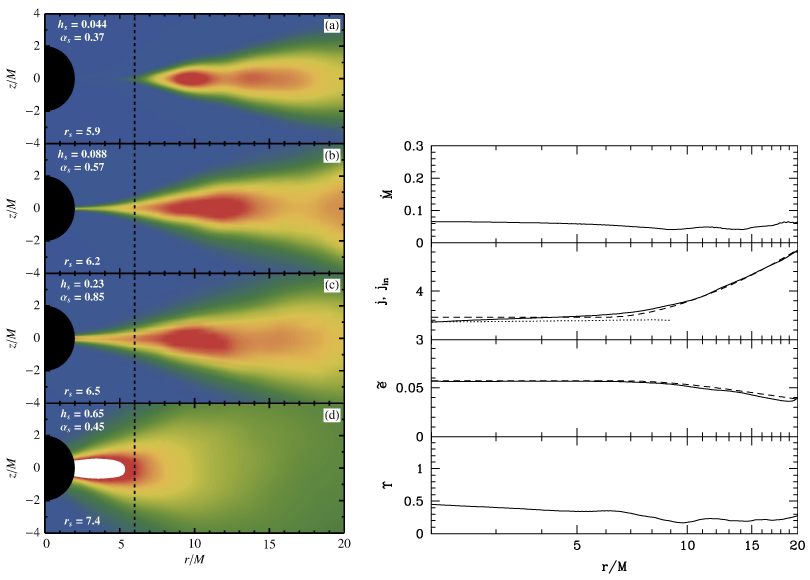 |
|
Figure 20: Left: Time-averaged rest mass density in the
 – –  plane for four GRMHD simulations
with plane for four GRMHD simulations
with  and various disk thicknesses. The dashed vertical line marks the ISCO. The disk opening
angle, and various disk thicknesses. The dashed vertical line marks the ISCO. The disk opening
angle,  , and effective Shakura–Sunyaev viscosity, , and effective Shakura–Sunyaev viscosity,  , are reported in each panel. The
top three panels have , are reported in each panel. The
top three panels have  and the inner edge of the disk is located outside the ISCO. The
bottom panel has and the inner edge of the disk is located outside the ISCO. The
bottom panel has  and the density increases monotonically down to the event horizon.
Figure from [241]. Right: Various fluxes as functions of radius for a numerical Novikov–Thorne disk
simulation. Top: Mass accretion rate. Second panel: Accreted specific angular momentum. Solid line
is simulation data; dashed line gives Novikov–Thorne solution; dotted line is ISCO value. Note that
the specific angular momentum does not drop significantly inside the ISCO, unlike for thick disks,
such as in Figure 17. Third panel: The “nominal” efficiency, which is the total loss of specific energy
from the fluid. Bottom panel: Specific magnetic flux. The near constancy of this quantity inside the
ISCO is an indication that magnetic stresses are not significant in this region. Image reproduced by
permission from [240]. and the density increases monotonically down to the event horizon.
Figure from [241]. Right: Various fluxes as functions of radius for a numerical Novikov–Thorne disk
simulation. Top: Mass accretion rate. Second panel: Accreted specific angular momentum. Solid line
is simulation data; dashed line gives Novikov–Thorne solution; dotted line is ISCO value. Note that
the specific angular momentum does not drop significantly inside the ISCO, unlike for thick disks,
such as in Figure 17. Third panel: The “nominal” efficiency, which is the total loss of specific energy
from the fluid. Bottom panel: Specific magnetic flux. The near constancy of this quantity inside the
ISCO is an indication that magnetic stresses are not significant in this region. Image reproduced by
permission from [240]. |

